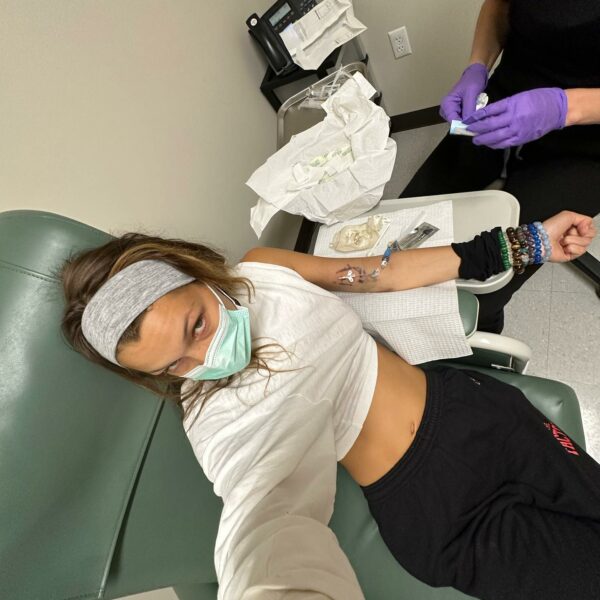We exist in a call-out culture that makes it so easy to judge other people. Oftentimes, this judgment is coming from our cozy perch safely at home, behind our screens. Maybe we love to delve into some hot goss, totally un-self-aware style. The bottom line is, so often the most obvious behaviors to us are the ones we exhibit ourselves.
If spotting a specific behavior comes to you at lightning speed, chances are, ya got it. Or at least a deeply personal, experiential understanding of it. It’s natural to pass judgment on others, but it’s also important to reflect instead of deflect. It’s a great opportunity to nurture healing, productive self-worth rather than projecting. As Shakespeare famously says, “Assume a virtue, if you have it not.”
So just how do we break our own behavioral patterns? Well, the first step is, of course, the aforementioned acceptance. That might be the same in any 12-step program. However, we aren’t here to outline a strict 12 steps, nor are we expecting anyone to pencil in some sort of Chronic Insecurity Anonymous meetings. This is about the brain.
The brain is incredibly plastic. Not plastic like your kiddie toys from Mattel, or what’s ruining our oceans and staying shiny and whole in our landfills for the foreseeable future. Plastic as in flexible. When we feed behavioral patterns, they stay locked in. But we are able to grow, change, expand, and manipulate our cognitive patterns through neuroplasticity. The National Library of Medicine defines it best as “the ability of the nervous system to change its activity in response to intrinsic or extrinsic stimuli by reorganizing its structure, functions, or connections.”
Addiction and Wellness Specialist, Erica Spiegelman, understands that there are scientific ways to rewire, and they don’t require much more than our commitment to the change.
“When we spot things or behaviors in people, it’s usually because it resonates, or we relate to some degree. If someone acts in an unhealthy way and we see ourselves in that behavior and want to change, we can. To reprogram our thinking, to rewire our brain, and to become more confident in who we are, we have to create new and positive ways of thinking about ourselves.”
This starts with changing your thoughts. Of course, this sounds both incredibly simple as well as impossible all at the same time. It might seem that we aren’t in control of our thoughts, and they are in control of us, especially when they are negative or stressful. However, we can re-pattern them with positive notions, otherwise known as affirmations, as well as Cognitive Behavioral Therapy.
Cognitive Behavioral Therapy, or CBT, is rooted in the principle that any psychological problem is based on faulty or unhealthy ways of thinking. This can be from learned patterns of unproductive behavior. Learning to recognize (the acceptance step) our own distorted thinking and realizing that it is perpetuating the negative things we wish to change takes longer than a moment of quick reflection, a nod, and bumbling along to the next step.
CBT uses strategies to reevaluate our negative thinking in a more positive and yet realistic sense.
One strategy is to gain understanding of our behavior. Where does it come from?
Then, understand the behavior and motivation of others. Where does theirs come from? Do we react, or do we have compassion in turn?
Learn to default to problem-solving skills to cope with challenging or emotionally painful situations.
And, most importantly, develop a greater sense of confidence in our own abilities, foster a sense of self, and feel in control.
One of the ways in which we can actualize changing our thinking is via affirmations, Spiegleman tells us. The reason this practice is more difficult than it seems is because we have to believe the words we are saying to ourselves, and that won’t happen overnight. In fact, it will take a while, and we may feel grumpy or silly while doing them. Our brains may be flexible, but just like in yoga, we have to repeatedly stretch the muscle before finding that deep flow, that real change.
“Self-love and acceptance create the foundation upon which a healthy life is built. Focusing on self-care and investing in yourself may come easier for some than for others. We can start in small ways and build up from there,” Spiegelman suggests.
“Affirmations are simply statements that are designed to create self-change in the life of the individual who uses them. They can serve as inspiration, as well as everyday reminders. They also serve to focus attention on goals throughout our day, which in and of itself has the potential to promote positive and sustained self-change.
Some examples of affirmations to change your thinking:
You are understanding and kind-hearted.
You are powerful and can change your habits.
You can choose any life you want.
You can REPEAT and REPEAT! Change requires PRACTICING new habits.
It follows the principle ‘use it or lose it.’ What you can do:
You can consciously practice visualizing, thinking, feeling, and acting in alignment with your desired intention. When you do this, you will stop the unconscious habit of recycling the past and activate your ability to rewire your brain in the present moment.”
“Present moment” is a key phrase here. Mindful meditation is an extremely useful tool in rewiring our thinking because it encourages acute self-awareness. Not the kind of self-awareness that makes up debilitatingly insecure, but the kind that makes us also aware of the narratives we create about ourselves and others that drive our unhelpful, negative patterns.
Mindful meditation helps rein in the true meaning of neuroplasticity. It begins with recognition and awareness that change is possible, and implements habit-forming practices that push out the old modes of thinking, making way for the new. It coincides with the tried and true phrase in this realm, neurons that “fire together wire together,” meaning that the longer we train our neurons to fire, the more of them will, and the more acutely this occurs, the more they will strengthen and rewire. Think things like gratitude, joy, success, kinetic energy, attraction, feeling loved, and more.
The content provided in this article is provided for information purposes only and is not a substitute for professional advice and consultation, including professional medical advice and consultation; it is provided with the understanding that Poosh, LLC (“Poosh”) is not engaged in the provision or rendering of medical advice or services. The opinions and content included in the article are the views of the interviewee only, and Poosh does not endorse or recommend any such content or information, or any product or service mentioned in the article. You understand and agree that Poosh shall not be liable for any claim, loss, or damage arising out of the use of, or reliance upon any content or information in the article.






































